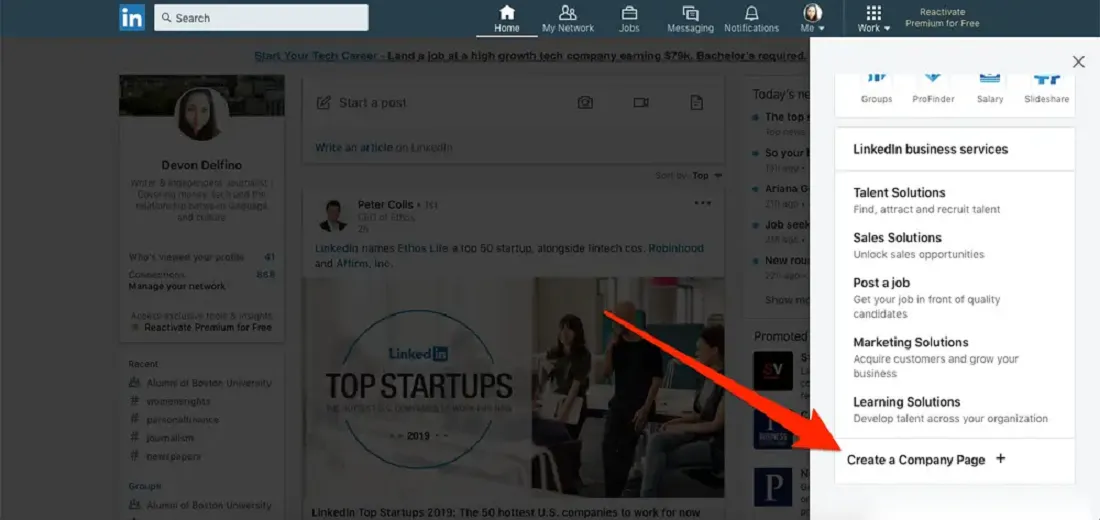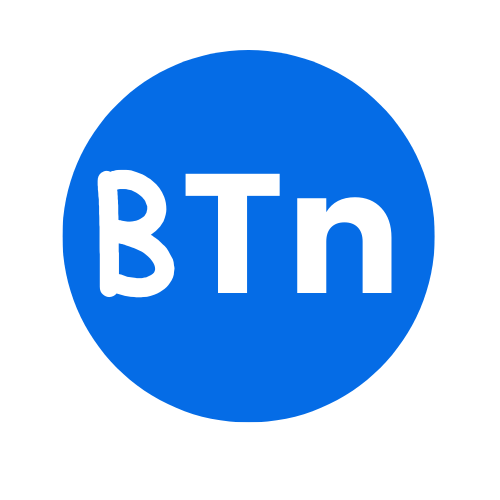Table of Contents
How to Start a Business Linkedin Page -
To create a business page on LinkedIn, you can establish a professional online presence for your company and effectively engage with a vast network of professionals. LinkedIn is a popular platform for businesses, providing opportunities to showcase your brand, share industry insights, and connect with potential clients and partners. Following the steps outlined below, you can create a compelling LinkedIn business page that represents your company’s values, attracts followers, and helps you achieve your business goals. Let’s dive into the process of creating a business page on LinkedIn.
1- Sign in to your LinkedIn account
I can guide you through the general steps to sign in to your LinkedIn account. Please follow these instructions:
- Open a web browser: Launch a web browser like Google Chrome, Mozilla Firefox, or Safari.
- Go to LinkedIn’s website: Type “www.linkedin.com” in the address bar of your web browser and press Enter. You will be directed to the LinkedIn homepage.
- Enter your login credentials: The login form is on the LinkedIn homepage. Enter the email address associated with your LinkedIn account in the “Email” field.
- Enter your password: Type your LinkedIn account password in the “Password” field. Make sure to enter it accurately to avoid any login issues.
- Click “Sign In”: Once you have entered your email address and password, click the “Sign In” button. LinkedIn will then verify your credentials.
- Complete any additional security steps: Depending on your account settings and security measures, LinkedIn may prompt you to complete additional steps to verify your identity, such as entering a verification code sent to your email or phone number.
- Access your LinkedIn account: If your login credentials are correct and you’ve completed any necessary security steps, you will be successfully signed in to your LinkedIn account. You should now have access to your profile, connections, and other LinkedIn features.
2- Access the LinkedIn Menu:
To access the LinkedIn menu, please follow these steps:
- Open a web browser: Launch a web browser like Google Chrome, Mozilla Firefox, or Safari.
- Go to LinkedIn’s website: Type “www.linkedin.com” in the address bar of your web browser and press Enter. You will be directed to the LinkedIn homepage.
- Sign in to your LinkedIn account: Enter your email address and password in the respective fields on the LinkedIn homepage. Click the “Sign In” button to log in to your account.
- Navigate to the LinkedIn homepage: After signing in, you will be redirected to the LinkedIn homepage. You can also click on the LinkedIn logo at the top left corner of the page to go to the homepage.
- Locate the LinkedIn menu: Look for the navigation menu on the LinkedIn homepage. It is typically positioned at the top of the page, just below the search bar. A series of options or icons represent the LinkedIn menu.
- Access the LinkedIn menu: Click on the menu icon or the option that represents the LinkedIn menu. It may be denoted by three horizontal lines, a grid icon, or the word “Work.” This will expand or open the LinkedIn menu.
- Explore the LinkedIn menu: Once the menu is open, you will see a dropdown or a sidebar with various options. These options typically include sections like “Home,” “My Network,” “Jobs,” “Messaging,” and more.
- Navigate within the LinkedIn menu: Click on the desired option to access different LinkedIn sections. For example, clicking “My Network” will take you to the section where you can manage your connections and discover new professionals.
3- Select "Create a Company Page
To select “Create a Company Page” on LinkedIn, follow these steps:
- Access the LinkedIn Menu: After signing in, click on the “Work” dropdown menu in the top right corner of the LinkedIn homepage. This will open a dropdown menu with various options.
- Select “Create a Company Page”: In the dropdown menu, scroll down and locate the “Create a Company Page” option. Click on it to proceed.
- Choose a Page Type: On the LinkedIn Business Services page that opens, you will be presented with different LinkedIn business pages. Select the type of page that suits your business. The options may include “Small business,” “Medium to large business,” or “Showcase page.” Choose the most appropriate option and click on it.
- Enter Company Details: After selecting the page type, you will be prompted to enter the details of your company. Fill in the requested information, including your company page’s official company name, work email address, and the LinkedIn public URL. Provide the required details accurately.
- Click “Create page”: Once you have entered all the necessary information, click the “Create page” button or a similar option. This will initiate the process of creating your LinkedIn company page.
After clicking “Create page,” LinkedIn may guide you through additional steps to customize and optimize your company page, such as adding a logo, cover image, and company description. Follow the on-screen instructions to complete the setup process and make your LinkedIn business page more appealing and informative to visitors.
4- Choose a Page Type
When creating a company page on LinkedIn, you must choose the appropriate page type that best aligns with your business. Here are the available page types on LinkedIn:
- Small business: This page type is suitable for small businesses or startups. It lets you showcase your company’s products, services, and updates to a broad LinkedIn audience.
- Medium to large business: This page type is designed for medium to large-sized businesses. It provides additional features such as career opportunities, company insights, and detailed analytics to help you engage with professionals and attract top talent.
- Showcase page: Showcase pages are meant to highlight specific brands, products, or initiatives within your organization. These pages can be linked to your main company page, allowing you to create targeted content for a specific audience.
To choose the appropriate page type:
- Sign in to your LinkedIn account.
- Access the LinkedIn Menu by clicking the “Work” dropdown menu at the top right corner of the LinkedIn homepage.
- Select “Create a Company Page” from the dropdown menu.
- Review the available page types on the LinkedIn Business Services page (Small business, Medium to large business, Showcase page) and choose the one that aligns with your company’s size and goals.
- Click on the page type you’ve selected to proceed with creating your LinkedIn company page.
5- Enter Company Details
When creating a company page on LinkedIn, you must provide specific details about your company. Here are the common company details that you will need to enter:
- Official Company Name: Enter the full and official name of your company. Make sure to use the correct legal name of your organization.
- Work Email Address: Provide a valid work email address associated with your company. This email address will be used for communication and verification purposes.
- LinkedIn Public URL: Choose a unique LinkedIn public URL for your company page. This URL will serve as the web address for your company page, making it easier for people to find and access your page. Try to keep the URL simple and representative of your company’s name.
- Company Description: Craft a compelling and concise description of your company. This section allows you to provide an overview of your company’s mission, values, products, services, and unique selling points. Aim to engage your target audience and communicate your brand identity effectively.
- Website URL: Include the website URL of your company if you have one. This will allow visitors to your LinkedIn company page to easily navigate to your website for more information.
- Industry: Select the industry that best represents your company from LinkedIn’s available options. Choose the industry that closely aligns with your business.
- Company Size: Specify the size of your company by selecting the appropriate range provided by LinkedIn. This helps LinkedIn categorize your company appropriately and target your page to the right audience.
- Location: Indicate the primary location or locations where your company operates. This will help LinkedIn users find your company page based on location-specific searches.
6- Customize Your Page:
Once you have created your LinkedIn company page, it’s essential to customize it to reflect your brand identity and engage your target audience effectively. Here are steps to help you customize your page:
- Logo and Cover Image: Add a professional, high-quality logo representing your company. This logo will appear on your page and in search results, so using a clear and recognizable image is crucial. Additionally, consider uploading a compelling cover image representing your brand or showcasing your products/services.
- Company Description: Craft a compelling and concise company description. Highlight your unique value proposition, key offerings, and what sets your company apart. Use engaging language and keywords relevant to your industry to attract your target audience.
- About Section: Use the “About” section to provide more detailed information about your company. Share your company’s mission, history, achievements, and other relevant information valuable to visitors. Make sure to emphasize your company’s strengths and values.
- Showcase Pages (if applicable): If you have different brands, products, or initiatives within your company, consider creating showcase pages. These allow you to focus on specific aspects of your business and tailor content to targeted audiences. Customize each showcase page with unique logos, cover images, and descriptions.
- Careers Section: To attract talent, utilize your page’s “Careers” section. Provide information about job openings, company culture, employee benefits, and other details that appeal to potential candidates. Make sure to link to your company’s career page or job listings.
- Content Strategy: Develop a content strategy for your LinkedIn page. Share relevant and engaging content such as industry insights, thought leadership articles, company news, product updates, and success stories. Use a mix of text, images, videos, and other media formats to make your posts more engaging.
- Engage with Followers: Respond to your page’s comments, messages, and engagement. Engaging with your followers fosters a sense of community and helps build relationships. Regularly monitor your page for notifications and interact with your audience promptly and professionally.
- Analytics and Insights: LinkedIn provides analytics and insights for company pages. Utilize these tools to track the performance of your page, understand your audience, and optimize your content strategy accordingly. Pay attention to metrics like page views, engagement, and follower demographics.
7- Add Page Admins
To add page admins to your LinkedIn company page, follow these steps:
- Go to your LinkedIn company page: Navigate to your LinkedIn company page by clicking on the “Work” dropdown menu at the top right corner of the LinkedIn homepage and selecting your company page from the “Manage” section. If you have multiple pages, choose the relevant one.
- Access the Admin tools: On your LinkedIn company page, click on the “Admin tools” dropdown menu in the top right corner. It may appear as three horizontal dots or as the word “Admin tools.”
- Select “Page admins”: Choose the “Page admins” option from the Admin tools dropdown menu. This will take you to the page where you can manage the administrators for your company page.
- Add page admins: On the “Page admins” page, you will see a list of current administrators for your company page, if any. Click the “Add admin” button to add a new page admin.
- Enter admin details: In the dialog box that appears, enter the name or email address of the LinkedIn member you want to add as an admin. As you type, LinkedIn will suggest matching profiles from your connections or allow you to enter the email address manually.
- Confirm admin selection: Once you have entered the name or email address, click on the correct profile from the suggestions or confirm the email address if manually entered. The person will receive a notification to accept the admin request.
- Admin request acceptance: The individual you have added as an admin will receive a notification on LinkedIn or an email requesting to become an admin of your company page. They need to accept the request to become an admin.
- Manage admin roles: After the admin has accepted the request, you can manage their roles and permissions on the “Page admins” page. You can assign them as Super Admins with full control over the page or as Content Admins with editing and posting capabilities.
8- Publish and Promote Content
Publishing and promoting content on your LinkedIn company page can help increase visibility, engage your audience, and build your brand. Here are the steps to publish and promote content on your LinkedIn company page:
- Sign in to your LinkedIn account: Visit the LinkedIn homepage (www.linkedin.com) and sign in using your email address and password.
- Go to your LinkedIn company page: Navigate to your LinkedIn company page by clicking on the “Work” dropdown menu at the top right corner of the LinkedIn homepage and selecting your company page from the “Manage” section. If you have multiple pages, choose the relevant one.
- Click on the “Content” tab: Once on your company page, click on the “Content” tab. This will take you to the content management section of your company page.
- Create a new post: Click the “Create a post” button to publish a new post. This will open a text editor where you can compose your content.
- Add content: Write your post content in the text editor. You can include text, images, videos, and links to external resources. Consider using a mix of formats to make your content more engaging.
- Customize the post: Use the formatting options in the text editor to customize your post. You can add headings, bold or italicize text, create bulleted or numbered lists, and more. Make sure to optimize your post for readability and visual appeal.
- Tag relevant individuals or companies: If applicable, tag individuals or other companies in your post using the “@” symbol followed by their name. This can help increase the visibility of your post and notify those you have tagged.
- Publish the post: Once satisfied with your content and any accompanying media, click on the “Post” button to publish it on your LinkedIn company page. Your post will now be visible to your page followers and potentially to a wider LinkedIn audience based on engagement and algorithms.
- Promote the post: Consider promoting it to reach a larger audience after publishing it. LinkedIn offers paid advertising options, such as Sponsored Content and Sponsored InMail, to help you target specific demographics and increase the visibility of your content. You can explore these advertising options through the LinkedIn Campaign Manager.
- Engage with comments and shares: Monitor the comments and shares on your posts and engage with your audience by responding to comments and questions. This helps build relationships, foster discussions, and showcase your company’s expertise.
- Analyze post performance: Use the analytics and insights provided by LinkedIn to track the performance of your posts. Assess impressions, engagement, click-through rates, and audience demographics. This data can help refine your content strategy and make informed decisions for future posts.





